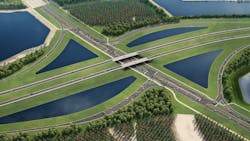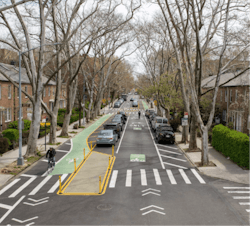Contractors Take Note: States are Driving Forward
By Mary Scott Nabers, Contributing Author
Although the current administration has frozen some federal funding programs, it appears that America’s transportation infrastructure will continue to receive support for statewide projects. State Departments of Transportation (DOTs) are investing in infrastructure upgrades, signaling sustained momentum.
A quick look at some of the upcoming opportunities provides insight into the types of contracting opportunities that will be available over the next several years.
Florida’s Department of Transportation (FDOT) has funding available for significant improvements to the state’s transportation infrastructure in 2025 and 2026. While the budget allocations for intersection rehabilitations are not yet detailed, this type of work will be prioritized.
Enhancing traffic flow and increasing safety will be a primary focus for FDOT over the next two years. Projects will include installing advanced traffic management systems and other types of upgrades to busy intersections.
Highway ramp construction also will be a priority, building on recent successes such as the newly completed $598 million Gateway Expressway in Pinellas County, which has improved connectivity, reduced congestion and eliminated bottlenecks.
Toll roads also will play a vital role in Florida’s transportation strategy. The ongoing First Coast Expressway project, a major controlled-access toll road, is not expected to reach completion until 2032 and will call for additional work that has not yet been solicited. The cumulative effort carries a projected cost of $2 billion.
Although specific tunnel maintenance funding is not outlined in current planning documents, FDOT leaders have emphasized a commitment to provide regular inspections and upkeep to all tunnels in the state, as well. That is expected to continue.
FDOT’s budget also includes funding for the agency’s Complete Streets initiatives. A redesign of U.S. Route1 in Palm Beach County will be launched to incorporate upgrades designed to improve safety and accessibility for pedestrians, bicyclists, transit riders and motorists. Contracting work will include construction of new bike lanes, pedestrian crosswalk enhancements and other traffic calming components.
Orlando has funding allocated to modernize and maintain its aging road and bridge infrastructure. City officials have earmarked over $11 million for street upgrades that will include resurfacing, sidewalk repair and enhanced safety technology.
One component of the plan includes $6.5 million for pavement rehabilitation across the city and extensions to key transportation corridors. Unlike large-scale expansion projects seen in other major cities, Orlando’s 2025 transportation plan is firmly rooted in tactical improvements and preventive maintenance.
City leaders plan to focus on the quality of existing infrastructure to minimize long-term repair costs. But a broader part of the strategy is to maintain infrastructure resiliency amid population growth, weather related events and increased usage.
City leaders in Miami have signaled their intent to address transportation infrastructure in 2025. Planning documents outline investments in roads and bridges and a $2 million state-funded Brickell Key Bridge rehabilitation project, one of the city’s major access points.
The work will include repairs to the superstructure and substructure, as well as roadway resurfacing and seawall stabilization. In addition to bridge rehabilitation, plans outline several road projects that include resurfacing projects, stormwater drainage upgrades and traffic-calming installations across multiple neighborhoods.
City leaders will coordinate these efforts with officials and support the Miami-Dade County Multiyear Capital Plan by leveraging a mix of local and state funds to support the projects. Currently, there appears to be no large-scale highway or new bridge construction.
The New York State Department of Transportation has released its funding allocations for fiscal year 2025–26, outlining substantial investments in key infrastructure areas. Work is planned for intersection rehabilitations along with projects related to highway ramps, toll roads, tunnel maintenance and complete streets enhancements.
A $7 million allocation for intersection rehabilitation on Long Island is planned with the goal of improving traffic flow and pedestrian safety at high-risk junctions. Toll road and bridge projects remain a central component of New York’s transportation priorities.
The fiscal year 25-26 budget includes $10.4 million to support Gateway Development Commission’s operations and $69.3 million for tunnel casing work connected to the Hudson Yards rail development. Additional bridge rehabilitations and replacements across the state have been allocated $17.3 billion through multi-year commitments.
In line with New York’s Complete Streets Act, the state will prioritize accessibility and multimodal travel. Funding amounts for complete streets projects are not available yet; however, the costs will be significant.
New York City will make investments in safer streets, modern infrastructure and pedestrian accessibility under its transportation and capital budget in 2025-2026. The city’s budget lists $40 million for street resurfacing, pedestrian infrastructure and ramp upgrades in the coming fiscal year.
The city’s most significant long-term infrastructure commitment centers on the Brooklyn-Queens Expressway. The capital plan allocates $652 million through 2029 for stabilization and reconstruction, with an additional $1.52 billion outlined in the 10-year capital strategy.
The city’s portfolio of approximately 800 bridges and tunnels will benefit from ongoing maintenance and planning, as well. Documents also call for $280 million per year baselined for street resurfacing, targeting over 1,100 miles of street annually, and enhancing at least 50 miles of protected bike lanes.
Albany is advancing a wide-ranging slate of transportation and infrastructure projects in its 2025–26 budget. A major component of the transportation spending will focus on Complete Streets projects, resurfacing and reconstruction of city corridors.
The work will also include new granite curbs, sidewalks, drainage improvements and street striping. Albany is also moving forward with design work for several critical intersection projects.
Albany also is expected to benefit from state-level funding for infrastructure projects such as the Livingston Avenue Bridge replacement and the ongoing Interstate-787 corridor redesign, which received $35 million for planning in the 2026 state budget.
As population growth in Texas continues to escalate, transportation agencies are rethinking how infrastructure can keep pace with massive road traffic.
The Texas Department of Transportation (TxDOT) has a 10-year plan that outlines projects valued at $104 billion over the next several years. Specific projects include highway widening, interchange improvements and roadway operational enhancements.
TxDOT has launched the Clear Lanes Initiative, a statewide program that targets major congestion hotspots in Houston, Dallas–Fort Worth, San Antonio and Austin.
A project to reconstruct 2.8 miles of Interstate-345 in Dallas County carries a projected cost of $1.65 billion. It will include rebuilding interchanges, improving connections and adding operational upgrades. This project is currently in the environmental phase, but solicitations are expected by 2027.
Officials in Orange County, Calif. will launch a Complete Streets initiative to enable cities to submit local projects to be funded in that area.
The funding will, in most cases, be used to supplement other local funding designated for launching multimodal infrastructure projects, which could include bike lanes, pedestrian sidewalks and safety features.
Earlier this year, the city of Fullerton was awarded a grant to improve Harbor Boulevard, one of the busiest routes that passes through densely populated areas. The $5.8 million project proposes reducing the number of lanes from six to four, installing buffered bike lanes and adding missing sidewalks on both sides of the road. It will also include a signalized intersection at the entrance of Brea Dam Park. Construction is projected to commence in the summer of 2026 and solicitations are slated for release in late 2025.
In California, a $12.7 billion infrastructure project to extend the Bay Area Rapid Transit (BART) has reached phase three of the extension to San Jose and Santa Clara. Recent reports state that the planned work to construct an underground tunnel to connect three underground stations has been halted until a new contractor for this phase can be selected.
The project is a regional priority, and it will obviously continue, so interested contractors should monitor the activity. Since the Valley Transportation Authority has decided to change contractors for the next phase of tunnel work, officials will delay completion dates, but statements indicate that construction should resume in 2027.
The volume and scope of upcoming transportation projects across the U.S. signals a continued focus on transportation infrastructure investment despite changing dynamics in federal funding.
From urban street enhancements and intersection upgrades to bridge rehabilitations and multimodal integrations, the opportunities for contractors are plentiful. However, competition for these projects will be significant.
Interested contractors should get involved now to lay the groundwork —identifying potential projects, reaching out to public-sector leaders and building strong ties with stakeholders. Taking a proactive approach and fostering relationships early are the necessary tasks that often lead to a competitive advantage when solicitations are released. RB
Mary Scott Nabers is president and CEO of Strategic Partnerships, Inc.


